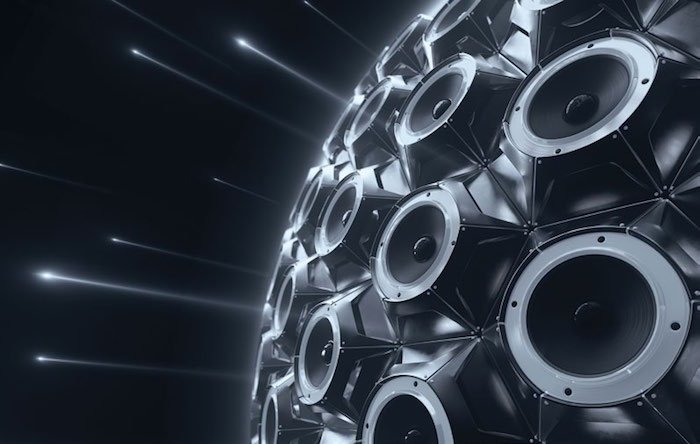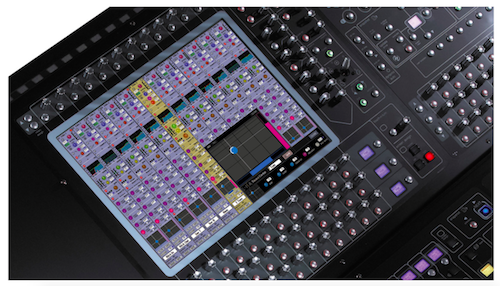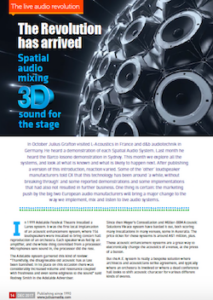News
25 Jan 2018
The Revolution has arrived: Spatial audio mixing

Subscribe to CX E-News
FEATURE: The live audio revolution
The Revolution has arrived: Spatial audio mixing – 3D Sound for the Stage
In October Julius Grafton visited L-Acoustics in France and d&b audiotechnik in Germany. He heard a demonstration of each Spatial Audio System. Last month he heard the Barco Iosono demonstration in Sydney. This month we explore all the systems, and look at what is known and what is likely to happen next. After publishing a version of this introduction, reaction varied. Some of the ‘other’ loudspeaker manufacturers told CX that this technology has been around ‘a while, without breaking through’ and some reported demonstrations and some implementations that had also not resulted in further business. One thing is certain: the marketing push by the big two European audio manufacturers will bring a major change to the way we implement, mix and listen to live audio systems.
In 1999 Adelaide Festival Theatre installed a Lares system. It was the first local implantation of an acoustic enhancement system, where 156 loudspeakers were installed to bring concert hall reproduction of an orchestra. Each speaker was fed by an amplifier, and the whole thing controlled from a processor. Microphones sent sound in, the processor did the rest.
The Adelaide system garnered this kind of review: “Thankfully, the disagreeable old acoustic has at last been banished. In its place on this occasion there was considerably increased volume and resonance coupled with freshness and even some edginess to the sound” said Rodney Smith in the Adelaide Advertiser.
Since then Meyer’s Constellation and Müller-BBM Acoustic Solutions Vivace system have battled it out, both scoring many installations in many venues, some in Australia. The price ticket for these systems is around A$1 million, plus.
These acoustic enhancement systems are a great way to electronically change the acoustics of a venue, at the press of a button.
But the A.E. system is really a bespoke solution where architects and acousticians strike agreement, and typically where an orchestra is involved or where a dead conference hall looks to shift acoustic character for various different kinds of events.
ENTER SPATIAL AUDIO MIXING – OR ‘3D’ FOR LIVE SOUND
Around 2010 the Fraunhofer Institute for Digital Media Technology in Germany started demonstrating their SpatialSound Wave technology. Audio designers recognized straight away that if implemented properly, this had the potential to revolutionise live sound.
While A.E. passively changed a venue’s acoustic, S.A. (as I’ll now call it) put the sound where the performer was. Instead of mono, or stereo, or even left-centre-right, a stage show could suddenly ‘come alive’ with voices seeming to come from each actor’s mouth, wherever they were.
Orchestral mixes suddenly expanded so that the various sections and instruments were separated in space.
Stunningly, a sound source could ‘follow’ a performer as they moved across a stage. Creatives and producers realized they could send sound anywhere, and are now dreaming up new material that embraces this technology.

At a d&d Soundscape presentation © CX Media
IT TOOK UNTIL NOW
Behind the scenes a lot was done by many. Fraunhofer met some loudspeaker manufacturers who reasoned that instead of installing a left / right loudspeaker system, they would now get a better slice of the pie by installing more.
A typical S.A. (3D) system requires at LEAST five separate speaker systems, typically across the top of the stage. Not every venue is suitable for this, but some A.E. is more nimble than that, allowing for compromises – but typically needing as many speaker systems as possible.
Subwoofers can still be used, as can outfill and sidefill which typically would take regular signal and serve traditional roles – while audience in ‘the zone’ will be treated to something they have not yet experienced.
Unlike A.E. with it’s ‘constellation’ of speakers, S.A. gives a designer options. With your minimum five speaker systems, you can add on front fill, and also place speakers in a ring around the outside of the listening area – if that’s what you want.
The developers at Fraunhofer licensed elements of their technology, and the four current systems emerged. Two of them have direct lineage to Fraunhofer dna, the other two are written from the ground up, according to the information offered to CX. CX has heard three of the four systems during October and November this year (2017). It needs to be said: this is difficult story to follow UNTIL you hear a demo. Once you do, it is akin to suddenly getting colour where until now you had black and white.

Digico have a plug-in for L-ISA
The four systems are, in no particular order, L-Acoustics L-ISA; the d&b Soundscape; Barco’s IOSONO; and Astro Spatial Audio from VanMunster BV. The first two are tied to loudspeaker systems and commissioning. The latter two are not. The order of arrival: Iosono has been in the market for some years, as has Astro Spatial, while L-Acoustics and d&b have both been offering demos and are now in production with mass release starting in 2018.
Iosono and Astro have systems in use, but the entry of the ‘big two’ loudspeaker brands, each of which has a similar market share (they both employ 400 people and ship 600 – 900 boxes a week) will bring spatial audio mixing to the masses.
There will be confusion. This isn’t Dolby Atmos. There are many derivate and production based products emerging that don’t quite do S.A., such as Sennheiser’s AMBEO. Expect to hear terms like sound scenography, augmented reality, object based audio and immersive media. Also you will collide with people who think this is just for virtual reality applications and movies. It is not. This was the future, and now it is reality.
The loudspeaker manufacturers who fail to seize this opportunity and who don’t market it properly will lose market share, if only because for every application of S.A., there are many more loudspeakers.
This article first appeared in the print edition of CX Magazine December 2017 as part of a special feature The live audio revolution pp.14-27 which included:
The Revolution has arrived: Spatial audio mixing – 3D Sound for the Stage
d&b Soundscape
Barco IOSONO
L-Acoustics L-ISA
L-Acoustics factory tour
d&b factory tour
CX Magazine is Australia and New Zealand’s only publication dedicated to entertainment technology news and issues. Read all editions for free or search our archive www.cxnetwork.com.au
© CX Media
Subscribe
Published monthly since 1991, our famous AV industry magazine is free for download or pay for print. Subscribers also receive CX News, our free weekly email with the latest industry news and jobs.





